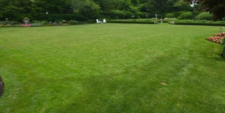Following best practice recommendations in every aspect of gardening can help save you time and money. The lawn is no different. Here are some guidelines for proper lawncare:
- Mowing height is dependent on turf variety, usage and time of year. Improve drought resistance by mowing at the taller end of the recommended range for your turf variety.
- No more than one-third of the height should be removed at each cutting. If the lawn has become overgrown you will need to cut it gradually over several days.
- Maintain a sharp mower blade to give a clean cut for the blades.
- Use a different mowing pattern each time to prevent soil compaction and wear from the mower wheels.
- Cultivate the soil around trees to prevent grass from growing close to the trunk so mowing equipment will not risk damaging the bark.
- Water in the early morning.
- Wait as long as possible between watering.
- Soak the soil to a depth of 6-8 inches when watering.
- Fertilize only to maintain moderately green color during favorable weather. Over-fertilizing increases water and mowing needs.
- Do not fertilize when heavy rain is expected.
- Time fertilizer based on variety:
- Fescue and bluegrass – September and November (optional in May)
- Bermudagrass and Zoysiagrass – between May and August
- Buffalograss – June

